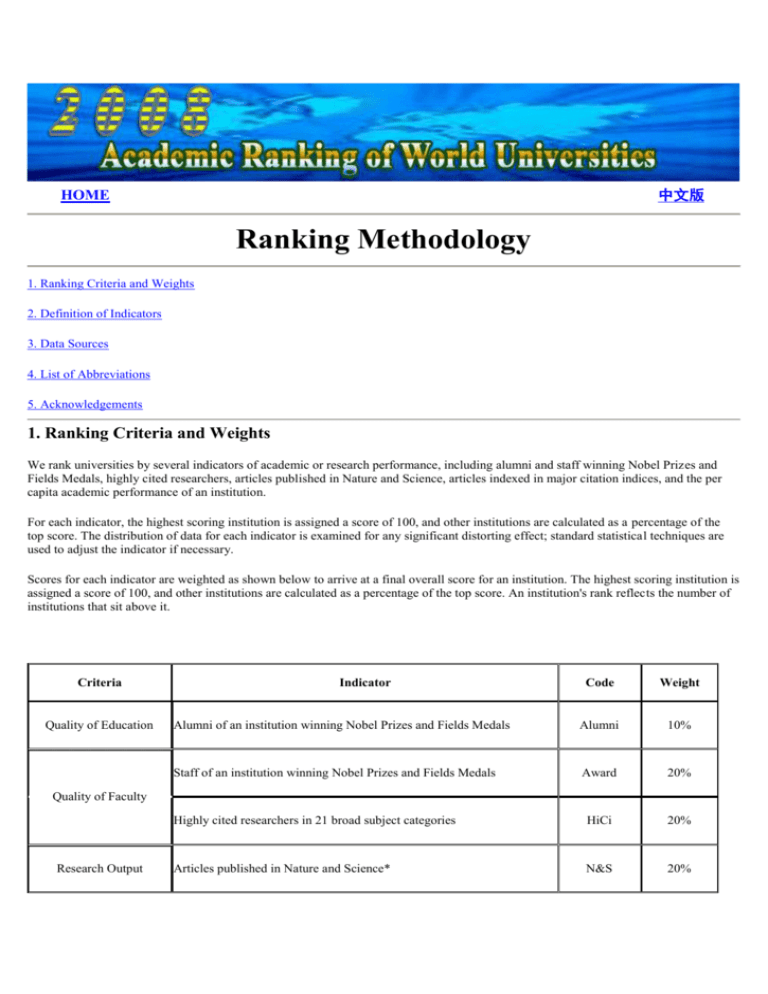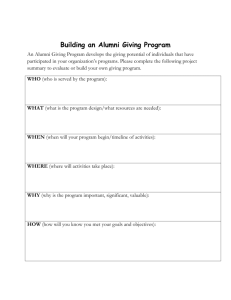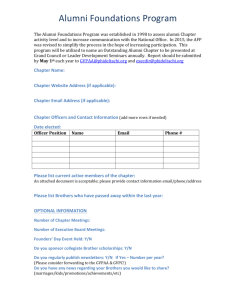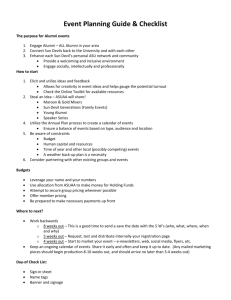
中文版
HOME
Ranking Methodology
1. Ranking Criteria and Weights
2. Definition of Indicators
3. Data Sources
4. List of Abbreviations
5. Acknowledgements
1. Ranking Criteria and Weights
We rank universities by several indicators of academic or research performance, including alumni and staff winning Nobel Prizes and
Fields Medals, highly cited researchers, articles published in Nature and Science, articles indexed in major citation indices, and the per
capita academic performance of an institution.
For each indicator, the highest scoring institution is assigned a score of 100, and other institutions are calculated as a percentage of the
top score. The distribution of data for each indicator is examined for any significant distorting effect; standard statistical techniques are
used to adjust the indicator if necessary.
Scores for each indicator are weighted as shown below to arrive at a final overall score for an institution. The highest scoring institution is
assigned a score of 100, and other institutions are calculated as a percentage of the top score. An institution's rank reflects the number of
institutions that sit above it.
Criteria
Quality of Education
Indicator
Code
Weight
Alumni of an institution winning Nobel Prizes and Fields Medals
Alumni
10%
Staff of an institution winning Nobel Prizes and Fields Medals
Award
20%
Highly cited researchers in 21 broad subject categories
HiCi
20%
Articles published in Nature and Science*
N&S
20%
Quality of Faculty
Research Output
Per Capita
Performance
Articles indexed in Science Citation Index-expanded, and Social Science
Citation Index
PUP
20%
Per capita academic performance of an institution
PCP
10%
0
100%
Total
0
* For institutions specialized in humanities and social sciences such as London School of Economics, N&S is not considered, and the
weight of N&S is relocated to other indicators.
2. Definition of Indicators
Alumni. The total number of the alumni of an institution winning Nobel Prizes and Fields Medals. Alumni are
defined as those who obtain bachelor, Master's or doctoral degrees from the institution. Different weights are set
according to the periods of obtaining degrees. The weight is 100% for alumni obtaining degrees in after 1991, 90%
for alumni obtaining degrees in 1981-1990, 80% for alumni obtaining degrees in 1971-1980, and so on, and finally
10% for alumni obtaining degrees in 1901-1910. If a person obtains more than one degrees from an institution, the
institution is considered once only.
Award. The total number of the staff of an institution winning Nobel Prizes in Physics, Chemistry, Medicine and
Economics and Fields Medal in Mathematics. Staff is defined as those who work at an institution at the time of
winning the prize. Different weights are set according to the periods of winning the prizes. The weight is 100% for
winners in after 2001, 90% for winners in 1991-2000, 80% for winners in 1981-1990, 70% for winners in 19711980, and so on, and finally 10% for winners in 1911-1920. If a winner is affiliated with more than one institution,
each institution is assigned the reciprocal of the number of institutions. For Nobel prizes, if a prize is shared by
more than one person, weights are set for winners according to their proportion of the prize.
HiCi. The number of highly cited researchers in 21 subject categories. These individuals are the most highly cited
within each category. The definition of categories and detailed procedures can be found at the website of Thomson
ISI.
N&S. The number of articles published in Nature and Science between 2003 and 2007. To distinguish the order of
author affiliation, a weight of 100% is assigned for corresponding author affiliation, 50% for first author affiliation
(second author affiliation if the first author affiliation is the same as corresponding author affiliation), 25% for the
next author affiliation, and 10% for other author affiliations. Only publications of article type are considered.
PUB. Total number of articles indexed in Science Citation Index-Expanded and Social Science Citation Index in
2007. Only publications of article type are considered. When calculating the total number of articles of an
institution, a special weight of two was introduced for articles indexed in Social Science Citation Index.
PCP. The weighted scores of the above five indicators divided by the number of full-time equivalent academic
staff. If the number of academic staff for institutions of a country cannot be obtained, the weighted scores of the
above five indicators is used. For ARWU 2008, the numbers of full-time equivalent academic staff are obtained
for institutions in USA, UK, France, Japan, Italy, China, Australia, Netherlands, Sweden, Switzerland, Belgium,
South Korea, Czech, Slovenia, New Zealand etc.
3. Data Sources
Nobel laureates. http://nobelprize.org/
Fields Medals. http://www.mathunion.org/medals/
Highly cited researchers. http://www.isihighlycited.com
Articles published in Nature and Science. http://www.isiknowledge.com
Articles indexed in Science Citation Index-Expanded and Social Science Citation Index.
http://www.isiknowledge.com.
Number of academic staff. Data is obtained from national agencies such as National Ministry of Education,
National Bureau of Statistics, National Association of Universities and Colleges, National Rector's Conference.
4. List of Abbreviations
Abbreviations used in the names of institutions are as follows:
Agr - Agriculture
Chem - Chemistry
China-hk - China - Hong Kong
China-tw - China - Taiwan
Coll - College
Fed - Federal
Inst - Institute
Med - Medicine
Natl or Nacl - National
Phys - Physics
Sch - School
Sci - Science
Tech - Technology
Univ - University
5. Acknowledgements
The Ranking Group (Professor Nian Cai LIU, Dr. Ying CHENG and Mr. Lin YANG) in the Center for WorldClass Universities, Graduate School of Education of Shanghai Jiao Tong University would like to express our
gratitude for those who have provided us with the number of academic staff or thoughtful comments and
suggestions.
If you will provide us statistical information on the detailed number of academic staff of institutions in your
country, we would very much appreciate. We are looking forward to receive more comments and suggestions from
you in the future.
Copyright©2008 Center for World-Class Universities, Shanghai Jiao Tong University, All Rights Reserved





